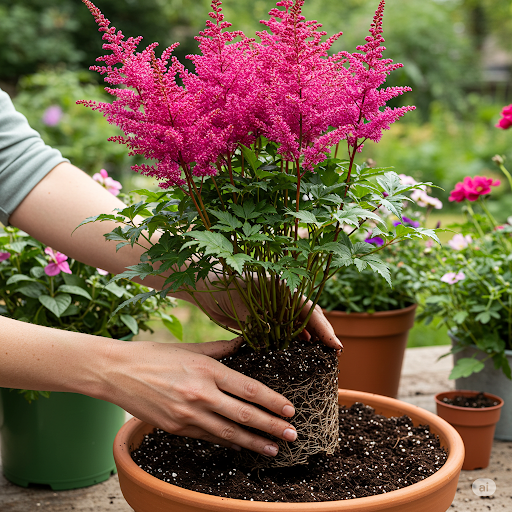Repotting Potted Astilbe: How Often and When is the Best Time?
Growing perennials like Astilbe in containers provides flexibility and beauty, allowing you to place their vibrant blooms exactly where you need them. However, unlike plants in the ground, containerized plants have limited space for roots to grow and limited soil volume for nutrients. Because of this, repotting becomes a necessary part of ongoing care.
So, does your potted Astilbe need frequent repotting, and when is the ideal time to refresh the soil and give it more room?
Does Potted Astilbe Need Frequent Repotting?
Astilbe does not typically need to be repotted every single year. They are moderate growers. However, they will eventually outgrow their container, and the potting mix will degrade over time.
Repotting becomes necessary when:
- The Plant is Root-Bound: The roots have filled the pot and are circling around the inside or growing out of the drainage holes.
- Soil is Depleted or Degraded: Potting mix breaks down over time, losing its structure and ability to hold water and nutrients effectively. Even with fertilizing, the soil itself needs refreshing.
- The Plant Shows Signs of Stress: Despite proper watering, light, and feeding, the plant may show stunted growth, yellowing leaves, or reduced flowering – often a sign its roots are crowded or the soil is exhausted.
On average, you can expect to repot your potted Astilbe every 2-3 years, depending on the size of the pot and the growth rate of the specific variety.
Signs Your Potted Astilbe Needs Repotting
Keep an eye out for these visual cues that indicate your Astilbe is ready for a new home or fresh soil:
- Roots Emerging: Roots are visible growing out of the drainage holes at the bottom of the pot.
- Water Drainage Issues: When you water, the water runs very quickly through the pot and out the bottom, indicating the soil isn't absorbing moisture well (often due to being packed with roots).
- Rapid Drying: The pot dries out much faster than it used to, requiring more frequent watering.
- Stunted Growth: The plant isn't growing as large or as vigorously as expected, or flowering is less impressive than in previous years.
- Top-Heavy Appearance: The plant visually looks too large for its container and might even tip over easily.
- Hard Soil Surface: The surface of the potting mix feels hard or compacted, or it's difficult to push your finger into the soil due to dense roots just below the surface.
When is the Best Time to Repot Potted Astilbe?
The optimal time to repot your potted Astilbe is in early spring, just as new growth is starting to emerge but before the leaves have fully unfurled or flower stalks begin to develop.
- Why Early Spring is Best: At this time, the plant is breaking dormancy and entering a period of active growth. The roots will quickly colonize the new soil, and the plant will recover more rapidly from any disturbance compared to being repotted during the heat of summer or while actively flowering.
- Secondary Option: Fall, after the foliage has died back but before hard freezes set in, is sometimes considered, but spring is generally less stressful as it aligns with the plant's natural growth cycle.
- Times to Avoid: Never repot Astilbe in the heat of summer or while it is actively blooming. This puts too much stress on the plant.
The Repotting Process (Briefly)
When it's time to repot:
- Carefully remove the Astilbe from its current pot. You might need to gently tap the pot sides or run a knife around the edge.
- Inspect the root ball. Gently loosen any roots that are tightly circling. If severely root-bound, you can make 2-3 shallow vertical cuts around the root ball's edge to encourage outward growth.
- Choose a new pot that is 1-2 inches larger in diameter than the old one, ensuring it has drainage holes. Alternatively, if the plant has become very large and crowded, you can divide it (split it into smaller sections) and replant one or more divisions into the same size pot with fresh soil.
- Add a layer of fresh, high-quality, well-draining potting mix to the bottom of the new pot.
- Place the Astilbe in the new pot so the top of the root ball is about an inch below the rim. The crown (where stems meet roots) should be at the same level as it was in the old pot.
- Fill in around the root ball with more fresh potting mix, tamping gently to remove air pockets.
- Water thoroughly until water drains from the bottom.
Repotting isn't a yearly chore for potted Astilbe, but paying attention to the signs your plant gives you and repotting in early spring with fresh soil and a slightly larger pot (or dividing) will ensure your Astilbe remains healthy, vigorous, and capable of producing beautiful blooms for years to come.
Article copyright by GreenShip


Comments
Post a Comment